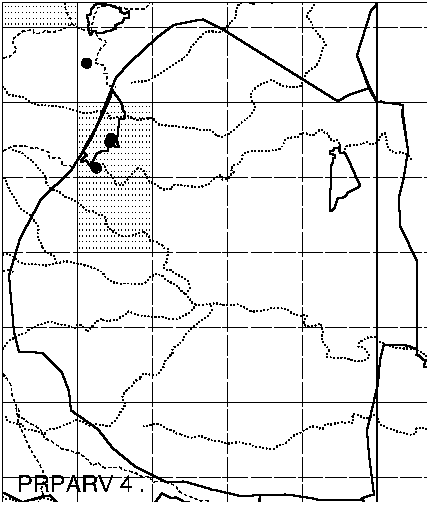
Home
Mission
Overview of Project
Project Staff
Sponsors
Achievements
Checking, Illustrations
Upcoming Activities
Id and Species Lists
Protea Information
Protea Gallery
Growing Proteas
Interim Dist. Maps
Publications
Afrikaanse Inligting
![]()
IDM Swaziland - Dainty Sugarbush - Protea parvula
 A solid black dot indicates where the species is found.
A solid black dot indicates where the species is found.
Protea parvula - Dainty Sugarbush is a low, sprawling shrub 0.08-0.16 m tall, with a rootstock producing numerous, sparsely-branched stems up to 1 m long. The stems are hairless, 2-4 mm diameter. The leaves point vertically from a horizontal stem (like teeth on a comb). Involucral bracts are hairless. The flowerheads have a long stalk.
Pr parv is very localized in Swaziland. There are in fact only 3 atlas records in Swaziland, two of which require verification – they could be Pr simplex. Please collect herbarium records for the Swaziland Herbarium:
- 2631 AA: IAG 970404 01– 26o07.92’S 31o06.47’E 1460m A small koppie N Forbes Reef Dam. 0.4km S Logwaja. – Frequent clumped.
- 2631 AA: IAG 970404 05- 26o07.17’S 31o06.83’E 1460m On spur near Logwaja Koppie just N of Forves Reef Dam. 1.0km NNE Logwaja – Frequent clumped.
Both of these have been atlassed as Pr simplex as well! Please note the differences between the two species.
The following herbarium records require investigation – they might also be Pr
simplex:
This is a very cryptic species and could be far more common than generally thought. Please keep an eye open for this species.
Potential Problems
The difference between Pr parvula and Pr simplex, is that Pr parvula creeps along the ground, whereas Pr simplex has erect stems. Pr parvula also has long stalks to the flowerheads. Although this difference is quite distinctive, many people have misidentified plants of this species as Pr simplex, being caught out by its rarity and occasional plants that are more robust and more erect.